




This is a guide to help you identify some of the wonderful upland hay meadow flowers that Friends of the Lake District has restored on our land at High Borrowdale and Mazonwath near Little Asby Common. At High Borrowdale, the first meadow was created in 2005 and the second in 2013. The first meadow – one of the first in Cumbria – was sown using seeds from a nearby hay meadow. The second meadow used green hay from our restored meadow so their character is very similar. The Mazonwath meadow was restored in 2022, using the green hay technique and seed from nearby. The meadows are a beautiful addition to the traditional upland landscape, full of stunning, pollinator-encouraging blooms, all of which are native to Cumbrian hay meadows.
Our meadows are a great asset to both properties, increasing biodiversity, enhancing the landscape, helping slow the flow of surface water and providing a fantastic habitat. Over 97% of wildflower meadows have been lost since the 1930s when agricultural practices changed, with meadows being cut earlier before the seeds had time to drop for future years. This led to this dramatic loss in one of the richest habitats we have – a hay meadow can have over 150 different species of flower and grass, and support a myriad of insects, small mammals and birds, containing up to 40 species per square metre.
The best time of year to see the meadows in full bloom is mid-June to mid-July. The time will vary each year and also between the properties. There will also be a difference in appearance at the start of this period to the end, with the yellows and whites often coming first, followed by the purple flowers later. This is because the majority of early spring pollinators are flies; they cannot see colour so the light reflected by brighter white and yellow flowers will help to attract them.
The following species are the plants that you may see in our meadows. If our meadows are in flower, please stick to the defined paths until the meadows are cut.
Want to learn more about our land and the species you can find there? Look out for our other guides! www.friendsofthelakedistrict.org.uk/property-guides





EARLY FLOWERING
Meadow Vetchling (Lathyrus Pratensis)
Of the pea family, yellow flowers in pairs, spiky leaves end in tendrils | Height 1m
EARLY FLOWERING
Yellow Rattle (Rhinanthus Minor)
Annual with yellow flowers that ripen to brown sacks in which the seed rattle, toothed leaves | Height 50cm
EARLY FLOWERING
Marsh Marigold (Caltha Palustris)
5cm buttercup-like yellow flowers found in wet areas, dark green kidney-shaped leaves | Height 30cm
EARLY FLOWERING
Ox Eye Daisy (Leucanthemum Vulgare)
Large yellow and white daisylike flowers, tall stems, toothed leaves | Height 75cm
EARLY FLOWERING
Red Clover (Trifolium Pratense)
Red/crimson round flowers, clover leaves | Height 50cm

EARLY FLOWERING
Greater Birdsfoot Trefoil (Lotus Pedunculatus)
In damper areas, yellow clusters of flowers, erect stems | Height 1m


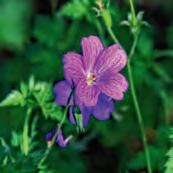
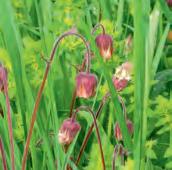
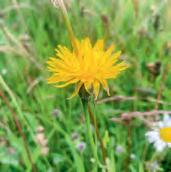
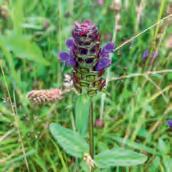
EARLY FLOWERING
(Conopodium Majus)
Has an edible tuber beloved of pigs, long delicate stems, umble heads of small, fluffy white flowers | Height 50cm
MID-SEASON FLOWERING
Eyebright (Euphrasia)
White flowers, may have purple veins and yellow centre, toothed leaves, semi-parasitic. Traditional remedy for sight problems | Height 35cm
MID-SEASON FLOWERING
Wood Cranesbill (Geranium Sylvaticum)
Mauve flowers with white centre, lobed leaves. Name comes from seed pods resembling a bird’s beak! | Height 70cm
MID-SEASON FLOWERING
Water Avens (Geum Rivale)
Bell-like, pinkish-orange coloured flowers, likes wet areas | Height 50cm
MID-SEASON FLOWERING
Rough Hawkbit (Leontodon Hispidus)
Of the dandelion family, and lots of varieties of hawkbit. Yellow flowers, hairy stems, toothed leaves | Height 60cm
MID-SEASON FLOWERING
Selfheal (Prunella Vulgaris)
Violet-purple flowers, oval leaves, hairy square stems. Used as a cure-all remedy in the Middle Ages! | Height 30cm



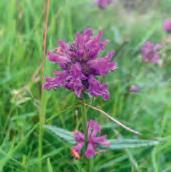
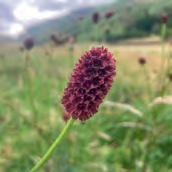

MID-SEASON FLOWERING
Lady’s Bedstraw (Galium Verum)
Green needle-like leaves, frothy puffs of tiny lime-green or yellow scented flowers. Traditionally used to scent ladies’ mattresses! | Height 30cm
LATE-SEASON FLOWERING
Melancholy Thistle (Cirsium Heterophyllum)
Thistle like large purple flowers, leaves have soft and pale underside | Height 1.2m
LATE-SEASON FLOWERING
Common Knapweed (Centaurea Nigra)
Purple, thistle-like flowers, pinnate (leaves on either side of the stem) rough leaves | Height 1m
LATE-SEASON FLOWERING
Betony (Stachys Officinalis)
Spikes of red-purple flowers, pairs of spiked stem leaves | Height 75cm
LATE-SEASON FLOWERING
Great Burnet (Sanguisorba Officinalis)
Deep red-purple petalless flowers, finely toothed pinnate leaves (leaves on either side of the stem) | Height 1.2m
LATE-SEASON FLOWERING
Meadow Sweet (Filipendula Ulmaria)
Frothy white-cream fragrant flowers on tall stem, likes damp areas | Height 1.2m
Established in 1934, Friends of the Lake District is a membership-based charity committed to looking after the landscapes of the Lake District and Cumbria.

Scan here to become a member today. Join us and over 6,000 people who are passionate about this magnificent place.
Friends of the Lake District’s land is open to the public and for all to enjoy! We own land from Threlkeld in the north, to Kendal in the south, and from Eskdale in the West, to Asby near Orton in the east. This is a mix of farmland, common land and woodlands.
Keswick
Rydal
For more information on our land, how to join us and help to maintain these beautiful Cumbrian landscapes or volunteering opportunities please get in touch, or sign up to our email newsletter.
Friends of the Lake District, Murley Moss, Oxenholme Road, Kendal, LA9 7SS
Tel: 01539 720788 | Email: info@fld.org.uk
Website: www.friendsofthelakedistrict.org.uk
� � #friendsofthelakedistrict
Registered Charity Number: 1100759
